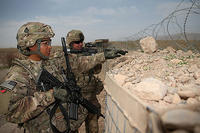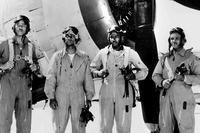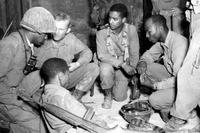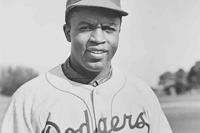When President Abraham Lincoln called for 75,000 volunteers to fight the rebellious Confederate states in 1861, it took little more than a week for the "First Defenders" to arrive in Washington.
Many of those volunteers arrived in the capital by train from Pennsylvania -- where infantry and artillerymen were raised from places like Allentown, Reading and Lewistown -- and made their way to the defense of their nation.
When Lincoln rode out to meet them, one of the first units he came across was Pottsville's 100-man Washington Artillery, which was already filled with wounded troops.
Among the men Lincoln met that day was 65-year-old Nicholas Biddle, a former slave, who was wearing the uniform of the Washington Artillery despite being forbidden to enlist as a soldier.
He was also bleeding from a wound on his head, the first blood shed in the Civil War up until that point (the only deaths at Fort Sumter, South Carolina, came from a cannon accident during the fort's evacuation).
Where Biddle escaped slavery isn't known, only that he came to freedom through the Underground Railroad and settled in Pottsville. He took a keen interest in the town's two companies of militia, even volunteering to join. But since Black men were forbidden to join as soldiers, he signed on as an aide to its commanding officer, Capt. James Wren.
In spite of the Army's regulations, Biddle's fellow Pennsylvanians came to accept the former slave as one of their own and allowed him to wear the uniform of the Washington Artillery. When the militia answered the president's call, Biddle came with them.
To get to Washington, Pennsylvania's First Defenders first had to march through Baltimore, which was filled with Confederate sympathizers at the time.
Wren told Biddle that the sight of a Black man in uniform would spark outrage in Baltimore and warned him that he could be captured and re-enslaved. The aide told his commanding officer that he was marching to D.C. with the trust of the lord and couldn't be scared by the devil himself.

The unit had to march across the city of Baltimore from one train station to another. For most of the journey, they were joined by a regular Army company and protected by local police, which somewhat limited the crowd's violence.
As the 475 Union troops moved through the city, residents pelted them with rocks, bottles and anything else that wasn't tied down. When the regular Army unit broke off and made for its station at nearby Fort McHenry, the crowd got even bolder, inflicting broken bones and other injuries.
Wren was right about the crowd's response to his Black aide. Being a Black man in uniform, Biddle suffered the worst of the mob. He was hit in the head by a brick as he boarded the second train, which caused a wound that not only knocked him down but caused him to bleed profusely.
By the time the 65-year-old Biddle arrived in Washington with his unit, the wound must have looked pretty bad, because President Lincoln implored him to seek medical attention. But Biddle stayed with the Washington Artillery.
The Pennsylvanians remained in garrison in the capital until July 1861, days before the first pitched battle of the war at Bull Run. With their three-month enlistments complete, they returned to Pottsville.
Eventually, most of them reenlisted for three years and went off to fight with the 48th Pennsylvania Infantry. As a group of former eastern Pennsylvania coal miners, they were instrumental in digging the tunnels under Petersburg, Virginia, that would lead to the infamous Battle of the Crater.
Biddle stayed in Pottsville, where he spent the rest of his life. When his fellow Pottsville veterans learned that he had died penniless in 1876 at age 80, they chipped in and gave their friend a full funeral, complete with Union-style headstone.
-- Blake Stilwell can be reached at blake.stilwell@military.com. He can also be found on Twitter @blakestilwell or on Facebook.
Want to Learn More About Military Life?
Whether you're thinking of joining the military, looking for post-military careers or keeping up with military life and benefits, Military.com has you covered. Subscribe to Military.com to have military news, updates and resources delivered directly to your inbox.















